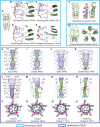Structure and Mechanism of Glycine Receptor Elucidated by Cryo-Electron Microscopy
- PMID: 36016557
- PMCID: PMC9395720
- DOI: 10.3389/fphar.2022.925116
Structure and Mechanism of Glycine Receptor Elucidated by Cryo-Electron Microscopy
Abstract
Glycine receptors (GlyRs) are pentameric ion channels that mediate fast inhibitory neurotransmission. GlyRs are found in the central nervous system including the spinal cord, brain stem, and cerebellum, as well as in the retina, sperm, macrophages, hippocampus, cochlea, and liver. Due to their crucial roles in counter-balancing excitatory signals and pain signal transmission, GlyR dysfunction can lead to severe diseases, and as a result, compounds that modify GlyR activity may have tremendous therapeutic potential. Despite this potential, the development of GlyR-specific small-molecule ligands is lacking. Over the past few years, high-resolution structures of both homomeric and heteromeric GlyRs structures in various conformations have provided unprecedented details defining the pharmacology of ligand binding, subunit composition, and mechanisms of channel gating. These high-quality structures will undoubtedly help with the development of GlyR-targeted therapies.
Keywords: agonist; antagonist; cryo-EM; gating mechanism; glycine receptor; inhibitory receptor; partial agonist; potentiator.
Copyright © 2022 Zhu.
Conflict of interest statement
The author declares that the research was conducted in the absence of any commercial or financial relationships that could be construed as a potential conflict of interest.
Figures

Similar articles
-
Molecular pharmacology of the glycine receptor chloride channel.Curr Pharm Des. 2007;13(23):2350-67. doi: 10.2174/138161207781368693. Curr Pharm Des. 2007. PMID: 17692006 Review.
-
Native glycine receptor subtypes and their physiological roles.Neuropharmacology. 2009 Jan;56(1):303-9. doi: 10.1016/j.neuropharm.2008.07.034. Epub 2008 Aug 3. Neuropharmacology. 2009. PMID: 18721822 Review.
-
Pharmacological characterization of glycine-gated chloride currents recorded in rat hippocampal slices.J Neurophysiol. 2002 Mar;87(3):1515-25. doi: 10.1152/jn.00365.2001. J Neurophysiol. 2002. PMID: 11877523
-
Characterization of the subunit composition and structure of adult human glycine receptors.Neuron. 2021 Sep 1;109(17):2707-2716.e6. doi: 10.1016/j.neuron.2021.08.019. Neuron. 2021. PMID: 34473954
-
Molecular structure and function of the glycine receptor chloride channel.Physiol Rev. 2004 Oct;84(4):1051-95. doi: 10.1152/physrev.00042.2003. Physiol Rev. 2004. PMID: 15383648 Review.
Cited by
-
Genetic Code Expansion for Mechanistic Studies in Ion Channels: An (Un)natural Union of Chemistry and Biology.Chem Rev. 2024 Oct 23;124(20):11523-11543. doi: 10.1021/acs.chemrev.4c00306. Epub 2024 Aug 29. Chem Rev. 2024. PMID: 39207057 Free PMC article. Review.
-
Structural studies of the human α1 glycine receptor via site-specific chemical cross-linking coupled with mass spectrometry.Biophys Rep (N Y). 2024 Dec 11;4(4):100184. doi: 10.1016/j.bpr.2024.100184. Epub 2024 Oct 10. Biophys Rep (N Y). 2024. PMID: 39393591 Free PMC article.
References
-
- Calvey T. N., Williams N. E. (2008). Principles and Practice of Pharmacology for Anaesthetists. Malden, Mass: Blackwell Pub.
Publication types
LinkOut - more resources
Full Text Sources
Miscellaneous

